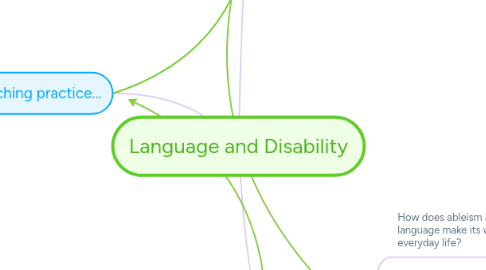
1. In our teaching practice...
1.1. Assessing the present school culture around disabilities, and student perceptions
1.1.1. Does your school discuss ability and disability?
1.1.2. How does the school culture discuss ability and disability?
1.2. Creating and sustaining a classroom culture that can hold difference and different ways of learning
1.2.1. We must hold discussions as a whole class, and one-on-one about difference. We should create opportunities for our students to discuss and reflect on differences across and within social, racial, ethnic, class, gender, sexuality, citizenship, and abilites groups.
1.2.2. Direct and intentional conversations about (dis)ability and how our classroom community will hold space for different ways of learning
1.2.3. Educators must call in ableist assumptions made in their own practice and classroom set-up by asking questions such as: Who is my classroom not designed for? How am I not yet thinking about?
1.2.4. Create s curriculum that provides students with the opportunities to shape their identities and relationship to ability in ways where they can SELF-LABEL
1.3. Our teaching practice cannot be divorced from our understanding of the power of language, and how language can be oppressive, and liberating.
1.3.1. In order for our teaching to be transformative of the social constructions of ability, we must present students with open language as well as the tools to reflect and question how we are interacting with each other's present, identities, and histories through langauge
2. The Master's Tools (Lorde)
2.1. The Master's Tools
2.1.1. Language is entrenched in all aspects of society as it propels us into multiple means of communication, including oral, non-verbal, and written. Our interactions are a reflection of our language. and our language is a reflection of how society constructs identity based on language
2.1.1.1. The language we use is a reflection of how we view each other: our capacities and limitations.
2.1.1.2. Langauge creates culture
2.2. Toni Morrison explains the "perils of living without language that falls outside the bounds of hegemony"
2.2.1. Those historically marginalized, those racialized, those deviating from standards of normalcy, particularly people whose minds and bodies do not reflect the status quo, have been deemed expendable and live without a language.
2.3. Can the master's tools dismantle the master's house?
2.3.1. If we continue to perpetuate ableist language around ability and our students' we will continue to perpetuate the hegemony of the status quo.
2.3.1.1. This is a disservice to our students who deviate from the norm, and harmful to the continued fear of difference that is entrenched in the status quo.
2.3.2. Ableist language is not useful to our teaching practice, students, and society
3. Issues
3.1. How does ableism and ableist language make its way into our everyday life?
3.2. How does ableism and ableist language make its way into our teaching practice?
3.2.1. How does ableism and ableist language make its way into our everyday life?
3.3. How does ableism and ableist language make its way into our students' lives & their family lives?
3.3.1. How do students perceive their (dis)ability?
3.3.1.1. In what ways do these perceptions impact their perception of self, others, and their learning?
3.3.2. How does a students' community impact their perception of (dis)ability?
